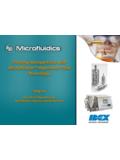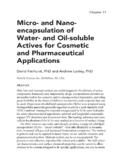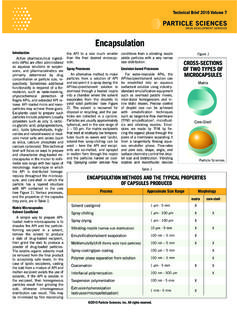Transcription of Microencapsulation: concepts, mechanisms, …
1 1304 Silva et ncia Rural, , , jul, : concepts, mechanisms , methods and some applications in food technologyMicroencapsula o: conceitos, mecanismos, m todos e algumas aplica es em tecnologia de alimentosPablo Teixeira da SilvaI* Leadir Lucy Martins FriesI Cristiano Ragagnin de MenezesI Augusto Tasch HolkemI Carla Luisa SchwanI velin Francine WigmannI Juliana de Oliveira BastosI Cristiane de Bona da SilvaII ISSN 0103-8478Ci ncia Rural, Santa Maria, , , , jul, 2014 Received Approved Returned by the author is a process in which active substances are coated by extremely small capsules. It is a new technology that has been used in the cosmetics industry as well as in the pharmaceutical, agrochemical and food industries, being used in fl avors, acids, oils, vitamins, microorganisms, among others.
2 The success of this technology is due to the correct choice of the wall material, the core release form and the encapsulation method. Therefore, in this review, some relevant microencapsulation aspects, such as the capsule, wall material, core release forms, encapsulation methods and their use in food technology will be briefl y words: microcapsules, microencapsulation , controlled microencapsula o um processo em que subst ncias ativas s o revestidas por c psulas extremamente pequenas. uma tecnologia nova, a qual tem sido empregada na ind stria de cosm ticos, farmac utica, agrot xicos e aliment cia e, nesta, utilizada em aromas, cidos, leos, vitaminas, micro-organismos, entre outros. O xito nessa tecnologia deve-se correta escolha do material encapsulante, da forma de libera o do n cleo e do m todo de encapsula o.
3 Dessa forma, nesta revis o, ser o abordados, sucintamente, alguns aspectos relevantes da microencapsula o, como a c psula, o material encapsulante, as formas de libera o do n cleo, os m todos de encapsula o, assim como sua utiliza o na tecnologia de : microc psulas, microencapsula o, libera o may be defi ned as the packaging technology of solids, liquid or gaseous material with thin polymeric coatings, forming small particles called microcapsules (GHARSALLAOUI et al., 2007). The polymer acts as a protective fi lm, isolating the core and avoiding the effect of its inadequate exposure. This membrane dissolves itself through a specifi c stimulus, releasing the core in the ideal place or at the ideal time (SUAVE, 2006). microencapsulation has numerous applications in areas such as the pharmaceutical, agricultural, medical and food industries, being widely used in the encapsulation of essential oils, colorings, fl avorings, sweeteners, microorganisms, among others (AZEREDO, 2005).
4 Recently, the food industry has demonstrated increasingly complex formulations: as microorganisms in fermented meat; the addition of polyunsaturated fatty acids that are susceptible to auto-oxidation in milk, yogurts or ice creams; and the use of fl avor compounds that are highly volatile in instant foods, which often can only be checked by microencapsulation (KHAN et al., 2011; GHARSALLAOUI et al., 2012). microencapsulation can serve as an effective means of creating foods that are not only a source of nutrients with sensory appeal but also a source of well-being and health for individuals, such as by increasing the level of calcium to prevent osteoporosis, using microorganism-produced lactic acid to decrease cholesterol and adding phenolic compounds to prevent heart problems (OLIVEIRA et al.)
5 , 2002; SANGUANSRI & AUGUSTIN, 2006).- REVIEW -IDepartamento de Tecnologia e Ci ncia dos Alimentos, Universidade Federal de Santa Maria (UFSM), Avenida Roraima, n 1000, 97105-900, Santa Maria, RS, Brasil. E-mail: *Autor para correspond de Farm cia Industrial, UFSM, Santa Maria, RS, : concepts, mechanisms , methods and some applications in food ncia Rural, , , jul, this review, some relevant aspects of microencapsulation , such as the capsule, wall material, core release forms, encapsulation methods and some of their uses in food technology will be briefl y , capsules can be classifi ed according to their size: macrocapsules (>5,000 m), microcapsules ( to 5,000 m) and nanocapsules (< m). In terms of their shape and construction, capsules can be divided into two groups: microcapsules and microspheres.
6 Microcapsules are particles consisting of an inner core, substantially central, containing the active substance, which is covered with a polymer layer constituting the capsule membrane. Mononuclear and polynuclear microcapsules can be distinguished by whether the core is divided (FAVARO-TRINDADE et al., 2008).In contrast, microspheres are matrix systems in which the core is uniformly dispersed and/or dissolved in a polymer network. Microspheres may be homogeneous or heterogeneous depending on whether the core is in the molecular state (dissolved) or in the form of particles (suspended), respectively (SILVA et al., 2003).Wall materialsThe correct choice of the wall material is very important because it infl uences the encapsulation effi ciency and stability of the microcapsule. The ideal wall material should have the following characteristics: not reactive with the core; ability to seal and maintain the core inside the capsule; ability to provide maximum protection to the core against adverse conditions; lack an unpleasant taste in the case of food applicability and economic viability (GHARSALLAOUI et al.)
7 , 2007; NAZZARO et al., 2012).According to F VARO-TRINDADE et al. (2008), most wall materials do not have all the desired properties; a common practice involves mixing two or more materials. Such materials can be selected from a wide variety of natural and synthetic polymers, including the following that we highlight: carbohydrates: starch, modifi ed starches, dextrins, sucrose, cellulose and chitosan; gums: arabic gum, alginate and carrageenan; lipids: wax, paraffi n, monoglycerides and diglycerides, hydrogenated oils and fats; inorganic materials: calcium sulfate and silicates; proteins: gluten, casein, gelatin and core releaseAccording to GOUIN (2004), encapsulation should allow the core to be isolated from the external environment until release is desired. Therefore, the release at the appropriate time and place is an extremely important property in the encapsulation process, improving the effectiveness, reducing the required dose of additives and expanding the applications of compounds of interest.
8 The main factors affecting the release rates are related to interactions between the wall material and the core. Additionally, other factors infl uence the release, such as the volatility of the core, ratio between the core and wall material, particle size and viscosity grade of the wall material (ROBERTS & TAYLOR, 2000).The main mechanisms involved in the core release are diffusion, degradation, use of solvent, pH, temperature and pressure. In practice, a combination of more than one mechanism is used (DESAI & PARK, 2005). Diffusion occurs especially when the microcapsule wall is intact; the release rate is governed by the chemical properties of the core and the wall material and some physical properties of the wall. For example, some acids can be released during a process step but protected by another step. In some cases, some preservatives are required at the product surface, but their spread to other parts must be controlled (AZEREDO, 2005).
9 According to ROSEN (2006), degradation release occurs when enzymes such as proteases and lipases degrade proteins or lipids, respectively. An example is reducing the time required for the ripening of cheddar cheese by 50% compared with the conventional ripening process (HICKEY et al., 2007).In contact with a solvent, the wall material can dissolve completely, quickly releasing the core or start to expand, favoring release. For example, microencapsulation of coffee fl avors improves the protection from light, heat and oxidation when in the dry state, but the core is released upon contact with water (FRASCARELI et al., 2012).The pH release occurs because pH changes can result in alterations in the wall material solubility, enabling the release of the core. For example, probiotic microorganisms can be microencapsulated to resist the acid pH of the stomach and only be released in the alkaline pH of the intestine (TOLDR & REIG, 2011).
10 Changes in temperature can promote core release. There are two different concepts: temperature-sensitive release, reserved for materials that expand or collapse when a critical temperature is reached, and fusion-activated release, which involves melting of the wall material due to temperature increase. An example is the fat-encapsulated cheese fl avor used in microwave popcorn, resulting in the 1306 Silva et ncia Rural, , , jul, distribution of the fl avor: the fl avor is released when the temperature rises to 57-90 C (PARK & MAGA, 2006).Pressure release occurs when a pressure is applied to the capsule wall, such as the release of some fl avors during the mastication of chewing gum (WONG et al., 2009). Some wall materials and the possible mechanisms for the microcapsules release are listed in table encapsulation methodsThe choice of the most suitable method depends on the type of core, the application for the microcapsule, the size of the particles required, the physical and chemical properties of the core and the wall, the release mechanism required, the production scale and the cost (SUAVE et al.)












